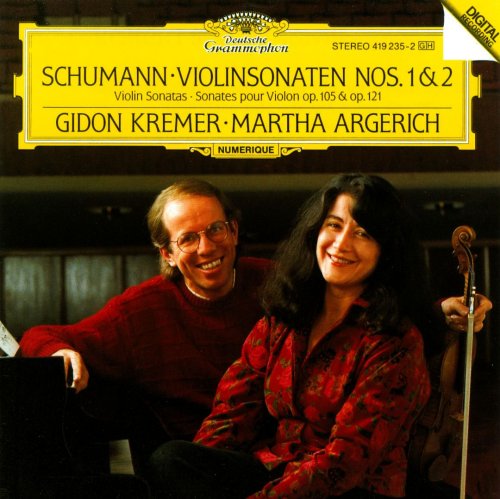
Gidon Kremer, Martha Argerich - Schumann - Violinsonaten Nos. 1 & 2 (1986)
BAND/ARTIST: Gidon Kremer, Martha Argerich
- Title: Schumann - Violinsonaten Nos. 1 & 2
- Year Of Release: 1986
- Label: Deutsche Grammophon
- Genre: Classical
- Quality: FLAC (tracks+.cue,log,scans)
- Total Time: 48:58
- Total Size: 217 Mb
- WebSite: Album Preview
Tracklist:
Sonate Nr. 1 Für Violine Und Klavier A-moll Op. 105
01. Mit Leidenschaftlichem Ausdruck
02. Allegretto
03. Lebhaft
Sonate Nr. 2 Für Violine Und Klavier D-moll Op. 121
04. Ziemlich Langsam – Lebhaft
05. Sehr Lebhaft
06. Leise, Einfach
07. Bewegt
Performers:
Gidon Kremer - Violin
Martha Argerich - Piano
Sonate Nr. 1 Für Violine Und Klavier A-moll Op. 105
01. Mit Leidenschaftlichem Ausdruck
02. Allegretto
03. Lebhaft
Sonate Nr. 2 Für Violine Und Klavier D-moll Op. 121
04. Ziemlich Langsam – Lebhaft
05. Sehr Lebhaft
06. Leise, Einfach
07. Bewegt
Performers:
Gidon Kremer - Violin
Martha Argerich - Piano
The name of Martha Argerich on any label always means fire, and so it is here. She and Gidon Kremer play with quite exceptional urgency and temperament, and the bright, clear recording brings up both instruments with a sheen. In fact the music springs at you with such immediacy that anyone previously of the opinion that Schumann was showing signs of tiredness in these latish works will be compelled to think again.
Though on CD Kremer and Argerich have the field to themselves, readers may recall that only six months ago another distinguished young ex-Soviet violinist, Eva Graubin, reintroduced these two sonatas to the LP catalogue with Theodore Paraskivesco (CBS). Mellow as it is, that recording cannot complete with this new one in sheer vividness of sound: the piano, in particular, emerges too boxy and once or twice is too heavy for the violin too. On musical grounds, however, honours are more equally divided. In both slow movements I think Graubin and Paraskivesco are the more genuinely Schumannesque.
In the A minor Sonata's Allegretto Kremer and Algerich slightly over-react to the main theme's strain of caprice, whereas Graubin and her partner are simpler, more natural, in phrasing. As for the D minor Sonata's chorale-inspired third movement, admittedly Graubin's opening pizzicato does not carry enough over Paraskivesco's piano, but their calmer approach conveys more of the music's underlying spirit of devoutness. Kremer and Argerich are surely wrong to ignore the composer's own leisurely metronome marking at the outset, the more so since after their excitable middle section they adopt it for the ending.
In the D minor Sonata's finale, the newcomers again outpace the composer's own metronome marking, compelling them to slow down for the more songful second subject. But since in this movement, like the first, Schumann does somewhat overwork his leading motif, the players' vitality and dynamic boldness are a tonic. I also think Kremer makes more of the lyrical episodes in the Scherzo than Graubin, though her softer-grained tone is just as pleasing as his brightness in terms of sound per se. That, however, is not the case in the A minor Sonata's finale, where Graubin's staccato semiquavers—especially in the lower register—are outweighed by the piano. In the opening movement of this more succinct First Sonata both teams are excellent.'
Though on CD Kremer and Argerich have the field to themselves, readers may recall that only six months ago another distinguished young ex-Soviet violinist, Eva Graubin, reintroduced these two sonatas to the LP catalogue with Theodore Paraskivesco (CBS). Mellow as it is, that recording cannot complete with this new one in sheer vividness of sound: the piano, in particular, emerges too boxy and once or twice is too heavy for the violin too. On musical grounds, however, honours are more equally divided. In both slow movements I think Graubin and Paraskivesco are the more genuinely Schumannesque.
In the A minor Sonata's Allegretto Kremer and Algerich slightly over-react to the main theme's strain of caprice, whereas Graubin and her partner are simpler, more natural, in phrasing. As for the D minor Sonata's chorale-inspired third movement, admittedly Graubin's opening pizzicato does not carry enough over Paraskivesco's piano, but their calmer approach conveys more of the music's underlying spirit of devoutness. Kremer and Argerich are surely wrong to ignore the composer's own leisurely metronome marking at the outset, the more so since after their excitable middle section they adopt it for the ending.
In the D minor Sonata's finale, the newcomers again outpace the composer's own metronome marking, compelling them to slow down for the more songful second subject. But since in this movement, like the first, Schumann does somewhat overwork his leading motif, the players' vitality and dynamic boldness are a tonic. I also think Kremer makes more of the lyrical episodes in the Scherzo than Graubin, though her softer-grained tone is just as pleasing as his brightness in terms of sound per se. That, however, is not the case in the A minor Sonata's finale, where Graubin's staccato semiquavers—especially in the lower register—are outweighed by the piano. In the opening movement of this more succinct First Sonata both teams are excellent.'
Classical | FLAC / APE | CD-Rip
As a ISRA.CLOUD's PREMIUM member you will have the following benefits:
- Unlimited high speed downloads
- Download directly without waiting time
- Unlimited parallel downloads
- Support for download accelerators
- No advertising
- Resume broken downloads


